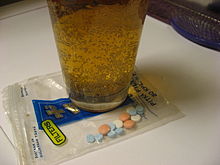Polysubstance use


| Polysubstance use | |
|---|---|
| Specialty | Psychiatry, narcology |
Polydrug use refers to the use of two or more psychoactive drugs in combination to achieve a particular effect. In many cases one drug is used as a base or primary drug, with additional drugs to leaven or compensate for the side effects of the primary drug and make the experience more enjoyable with drug synergy effects, or to supplement for primary drug when supply is low.[1]
Risks
Polydrug use often carries with it more risk than use of a single drug, due to an increase in side effects, and drug synergy. The potentiating effect of one drug on another is sometimes considerable and here the licit drugs and medicines – such as alcohol, nicotine and antidepressants – have to be considered in conjunction with the controlled psychoactive substances. The risk level will depend on the dosage level of both substances. If the drugs taken are illegal, they have a chance of being mixed (also known as "cutting") with other substances which dealers are reported to do to increase the perceived quantity when selling to others to increase their returns. This is particularly common with powdered drugs such as cocaine or MDMA which can be mixed with relative ease by adding another white powdery substance to the drug. This cumulative effect can lead to further unintended harm to health dependant on what is being maliciously added. Concerns also exist about a number of pharmacological pairings: alcohol and cocaine increase cardiovascular toxicity; alcohol or depressant drugs, when taken with opioids, lead to an increased risk of overdose; and opioids or cocaine taken with ecstasy or amphetamines also result in additional acute toxicity.[2] Benzodiazepines are notorious for causing death when mixed with other CNS depressants such as opioids, alcohol, or barbiturates.[3][4][5]
Scheduling
Within the general concept of multiple drug use, several specific meanings of the term must be considered. At one extreme is planned use, where the effects of more than one drug are taken for a desired effect. Another type is when other drugs are used to counteract the negative side effects of a different drug (e.g. depressants are used to counteract anxiety and restlessness from taking stimulants). On the other hand, the use of several substances in an intensive and chaotic way, simultaneously or consecutively, in many cases each drug substituting for another according to availability.[2]
Research
The phenomenon is the subject of established academic literature.[6]
A study among treatment admissions found that it is more common for younger people to report polydrug drug use.[7]
MDMA taken in combination with or the day after low doses of viagra (20mg) has been shown to reduce MDMA-induced serotonin deficit in rats by increasing resistance to MDMA-induced oxidative stress.[8][9]
See also
- Combined drug intoxication
- Drug overdose
- Recreational drug use
- Responsible drug use
- Speedball (drug)
References
- ^ http://www.emcdda.europa.eu/html.cfm/index34913EN.html
- ^ a b EMCDDA Annual Report 2006 ch. 8
- ^ Serfaty M, Masterton G (1993). "Fatal poisonings attributed to benzodiazepines in Britain during the 1980s". Br J Psychiatry. 163: 386–93. doi:10.1192/bjp.163.3.386. PMID 8104653.
- ^ Buckley NA, Dawson AH, Whyte IM, O'Connell DL. (1995). "[Relative toxicity of benzodiazepines in overdose.]". BMJ. 310 (6974): 219–21. doi:10.1136/bmj.310.6974.219. PMC 2548618. PMID 7866122.
{{cite journal}}: CS1 maint: multiple names: authors list (link) - ^ Drummer OH; Ranson DL (December 1996). "Sudden death and benzodiazepines". Am J Forensic Med Pathol. 17 (4): 336–42. doi:10.1097/00000433-199612000-00012. PMID 8947361.
- ^ Scholey AB, Parrott AC, Buchanan T, Heffernan TM, Ling J, Rodgers J (June 2004). "Increased intensity of Ecstasy and polydrug usage in the more experienced recreational Ecstasy/MDMA users: a WWW study". Addict Behav. 29 (4): 743–52. doi:10.1016/j.addbeh.2004.02.022. PMID 15135556.
{{cite journal}}: CS1 maint: multiple names: authors list (link) - ^ "Polydrug Use Among Treatment Admissions: 1998." OAS Home: Alcohol, Tobacco & Drug Abuse and Mental Health Data from SAMHSA, Office of Applied Studies. Web. 29 Sept. 2011. [1]
- ^ Puerta, E.; Hervias, I.; Goñi-Allo, B.; Lasheras, B.; Jordan, J.; Aguirre, N. (2009). "Phosphodiesterase 5 inhibitors prevent 3,4-methylenedioxymethamphetamine-induced 5-HT deficits in the rat". Journal of Neurochemistry. 108 (3): 755–766. doi:10.1111/j.1471-4159.2008.05825.x. PMID 19187094.
- ^ Puerta, E.; Barros-Miñones, L.; Hervias, I.; Gomez-Rodriguez, V.; Orejana, L.; Pizarro, N.; De La Torre, R.; Jordán, J. N.; Aguirre, N. (2011). "Long-lasting neuroprotective effect of sildenafil against 3,4-methylenedioxymethamphetamine- induced 5-hydroxytryptamine deficits in the rat brain". Journal of Neuroscience Research. 90 (2): n/a. doi:10.1002/jnr.22759.
